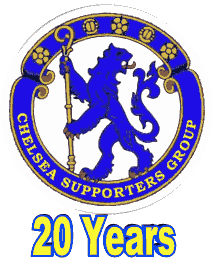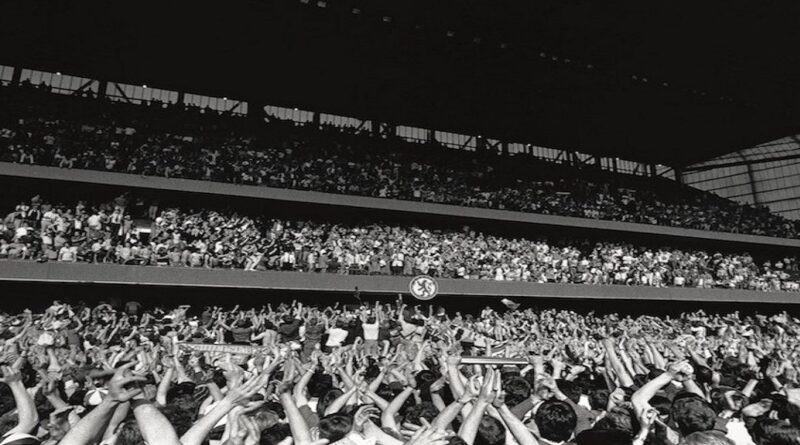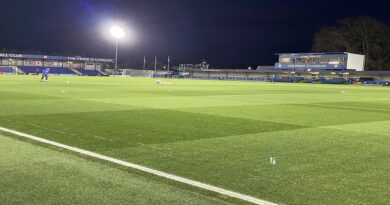Founders’ Day: The Birth of the Blues
From the official Chelsea FC website:
It is Chelsea Football Club’s birthday today! We were founded on this day, 10 March 1905, and to celebrate the occasion we have a special long read.
Our current campaign, 2022/23, has been notable for the highest number of Chelsea debuts since that original season when inevitably for a club just a few months old but with huge ambition, a major recruitment drive for new players took place. Who they were and where they came from is an intriguing tale, told here in this birthday feature by club historian Rick Glanvill…
When Noni Madueke entered the fray in the second half against Fulham at Stamford Bridge in place of Mykhalio Mudryk last month, it is unlikely he was aware of the noteworthy place in Chelsea history he was reserving for himself.
As debutant number 16 for the 2022/23 season, the England Under-21 winger ensured the current squad surpassed the 15 who made their bow for the Pensioners back in 1909/10, matched in 2017/18 by the likes of Toni Rudiger and Callum Hudson-Odoi. Racked by injuries in 1910, the relegation-threatened Londoners blooded so many new players that the Football League introduced the first transfer deadline day in response. But that is a tale for another day.
Of course, 16 is still not the most freshly registered footballers Chelsea have ever fielded in one season because, even further back, 27 embarked on their Stamford Bridge careers in the club’s inaugural season, 1905/06.
To mark our Founders’ Day on 10 March, almost 12 decades on from the famous meeting above the Rising Sun public house across the road from Stamford Bridge (now the Butcher’s Hook), this is the story of how that first squad was assembled, who was responsible, and the obstacles they overcame to make the new club such a success.
On the evening of 10 March 1905, the sports news agency J E Dixon & Co. sent out the following press release: ‘It has been decided to form a professional football club, to be called the Chelsea Football Club, for Stamford-bridge.’ Within three years Chelsea would have the highest average home attendance in the world.
Still missing was the head honcho: the manager. One candidate considered by the board was Londoner Frank Scott Walford, a former Tottenham player and referee who had just hung up his whistle. Walford’s tactical services were also sought by Norwich, but in the end he would join Brighton, then of the Southern League, and oversee three indifferent seasons.
Another hopeful for the Chelsea hot-seat was 40-year-old Archie Goodall. Born in Belfast and recently let go by Glossop North End after a mediocre showing, Goodall was keen on recruiting compatriots from Ireland. Snubbed by London’s newest club, he took over at Wolverhampton but lasted just one season.
Instead, around 23 March 1905 John Tait ‘Jacky’ Robertson, 28-year-old skipper of Scotland, half-back with Glasgow Rangers, and three-time league winner north of the border, was handed the reins of this brand-new sporting endeavour as player-manager.
Remember Chelsea had started from scratch three months earlier, with no pitch, no team, and no league to compete in. As Archibald Leitch’s grandstand took shape in the capacious former athletics grounds off the Fulham Road, Robertson – likewise forged from Scottish iron – began construction of the squad alongside Fred Parker: a wise athletics supremo, and the driving force as well as honorary financial secretary of the whole football club scheme.
The deadline for delivering a presentable line-up of recruits was 29 May 1905 – the day of the Football League’s annual meeting, when existing clubs would vote on which applicants to add to their roster, including the west Londoners. Robertson and Parker set out to spread the word of Chelsea’s plans, glad-handing League clubs in a whistle-stop tour and testing the water on transfer targets.
By late April the first names could finally be pencilled onto the team sheet. ‘The Birmingham club [then Small Heath, now City] and their manager, the late Alfred Jones, helped in every way,’ Parker recollected some years later. ‘It was in their club office that the first two Chelsea players were signed. These were Bob McRoberts, our original centre-forward, and subsequently centre half-back and captain, and James Robertson, an inside-right who scored many a goal for us in our early days.
‘And a week later Birmingham transferred to us a player destined to become known as “the Wizard” … the best man in that [inside-left] position known up to that time. I mean Jimmy Windridge. And you know what those three players cost us? The cheque to cover the transfers of the three players was exactly £340 – less than £120 apiece.’ All were genuine prospects worthy of elite football.
Remarkably, though, while Parker continued his steam-train diplomacy and contract-signing, Robertson reported back for his day job as a Rangers midfielder. In fact, the 28-year-old played six of his 27 games for the Gers that season after committing his future to the Londoners, and scored two of his five goals.
On top of that, the half-dozen games between 25 March and 6 May in which Robertson ‘moonlighted’ for the Ibrox club were hardly meaningless affairs for such perennial trophy-hunters. They included a Scottish Cup semi-final victory against bitter enemies Celtic, then the drawn final and a replay defeat by Third Lanark; and two vital league matches that clinched parity with their ‘Old Firm’ rivals on 41 points in the final table.
The stalemate meant a Scottish League play-off match against the Celts at neutral Hampden Park on 6 May. Robertson’s contribution in this fraught decider – adjudicated by a specially hired English referee Mr Kirkham – was the Gers’ consolation in a traumatic 2-1 loss.
With such playing commitments Robertson’s ability to contribute to squad-building for a club 350 miles to the south must have been stressful. The internet and messaging were 90 years away, and the Flying Scotsman railway train was the closest thing to a private jet waiting to whisk a new signing back to SW6.
However, the manager presumably maintained contact with Parker, wealthy owner Gus Mears or club secretary William Lewis via telephone (although it is not clear exactly when the Chelsea Football and Athletic Club’s phone line, ‘Kensington 1476’, was installed) or possibly telegram, the electronic message system that was an exercise in brevity, directed to the club’s ‘Chelstam’ address. Maybe they even discussed likely targets, fees and salaries in first-class letters – no one considered the postal service ‘snail mail’ back then.
Robertson certainly received unsolicited letters from people inspired by the Stamford Bridge project. One, he revealed, ‘from a man who said he was a splendid centre-forward but if that position was not vacant he could manipulate a turnstile’ and another claiming ‘you will be astonished to see me skip down the touch-line like a deer.’ Sadly, Bambi did not make the squad.
While Robertson was indisposed in Glasgow, newspapers in the know talked of a ‘Chelsea Committee’ making a list of targets and ticking recruits off one by one. Or, as it transpired, two by two: multiple talents arrived from several clubs such as Hearts, of Edinburgh, Tottenham and, naturally, Robertson’s own Rangers as well as Birmingham. Does that suggest an expedient ‘while we’re here, which of your team-mates should we grab too’ strategy?
More broadly, several of the assembled influencers at Chelsea brought great connections to the young club’s network. Club secretary Lewis had spent time at Brentford, while Robertson knew club director George Thomas, owner of Southampton’s Dell, and vice-president C B Fry (hailed as the ‘greatest living Englishman’) from his time with the Hampshire club. The Saints and Brentford were Southern League outfits, and it is no surprise many of the recruits came from the likes of Spurs and that rival competition, not the Football League.
Equally, Dumbarton-born international skipper Robertson would have been better-versed in Scotland’s bravehearts than other ‘committee’ members. More than a dozen squad members hailed from north of the border, presumably on his say-so as well as that of fellow Scot and highly-regarded first team trainer, Jimmy Miller, snapped up from West Brom at the start of May.
The speedy recruitment and carpetbagging set the Londoners up competitively for the Football League admission vote in a smoky room at the Tavistock Hotel in London’s Covent Garden at the end of that month. ‘We had a good case to present to the League, and had little fear,’ Parker recalled. ‘Thanks to the enterprise of the late Gus Mears we had a ground and stand more than equal to those of most League clubs, and the names of players already engaged were more than sufficient to convince everyone that the new club would do credit to the Second Division.
‘Goal: Will Foulke (Sheffield United; backs Mackie (Hearts), McEwan, (Glasgow Rangers), Miller (Falkirk); half-backs, J T Robertson, McRoberts, Key (from the Hearts); forwards, Martin Moran (Sheffield United and Millwall), Dave Copeland (Tottenham Hotspur), with his partner, Jack Kirwan, besides Windridge and Robertson.’
Other club representatives were impressed and elected Chelsea into League Division Two for 1905/06 ‘without ever kicking the ball as a club’. Some of them had more incentive than others. ‘The cheque was handed to Birmingham immediately after our election to the League,’ Parker explained. ‘If we had failed in the ballot the players would still have been ours but Birmingham [and other clubs] would not have received anything.’
Still the recruitment continued, and newspapers were immensely impressed.
‘Chelsea, having engaged J T Robertson, the international half, have scooped up players from far and near,’ observed the Edinburgh Evening News, ‘and if their playing elements blend they should make a very strong force. They must have paid an enormous sum in transfers. On paper this team will take a lot of beating.’
The Middlesex Independent felt ‘London’s latest first-class professional club, Chelsea, bids fair to make a name in the football world. In the first place, the club has a ground exceptionally well appointed, and old Stamford Bridge is today one of the best football rendezvous in the kingdom.
‘Burly W Foulke, late of Sheffield United, will be in charge of goal with M Byrne, who last season played with Southampton, as understudy. To use the words of Chelsea’s manager, Foulke is playing better than ever. R Mackie, who comes from the Heart of Midlothian Club, was one of the finest backs in Scotland last season. He stands 5ft 10½ins, weighs about 12st 4lbs, and is one of the fastest men playing. Then comes Tom Watson … a right-back of considerable promise.
‘Tom Miller, who comes to Chelsea from Falkirk, is regarded as one of the catches of the season. In the words of Mr Robertson he is thought to be the equal of the Manchester City player, Burgess, one of the best men that ever represented England in her international matches. R McEwan, who comes from the Glasgow Rangers, is another back of promise. He has also played for Bury, weighs 13st and stands 5ft 10½ins in his stockings. G Key, who comes from the Heart of Midlothian Club, is a Scottish international. He plays right half-back and is considered one of the finest halves in that position playing. He is diminutive in size but he is a fearless tackler and a rare good feeder of his forwards.
‘Chelsea have also secured R McRoberts, the late centre-forward of Small Heath. Some people consider him the best man in that position now playing, but he will probably play centre half-back for Chelsea. “Jock” Robertson, one of the finest of footballers will play for the club he manages. Craigie, from Manchester City, will make a useful right- or centre-half and others who are expected to render useful service are Wolff, from Hull City, and old Millwall man Mike Moran. But more important than all it is interesting to note that “Davie” Copeland and John Kirwan, late of Tottenham Hotspur, will figure in the Chelsea ranks. The former will play inside-right to Moran, and the Irish international and J Windridge, late of Birmingham Small Heath, are expected to make an excellent pair on the left, Kirwan, of course, playing outside.’
The Daily Mail enthused: ‘The new Chelsea Football Club is going to make a big name in the football world. Mr H A [Gus] Mears does not believe in half measures and no expense is being spared in launching the club on what should prove to be a prosperous career.’
inaugural game for Chelsea at Stockport County. Willie Foulke, Robert Mackie, Robert McEwan, George Key, Bob McRoberts, Thomas Miller, Martin Moran, James Robertson, David Copeland, James Windridge and Jack Kirwan, a big box-office line-up, inspired a record attendance at Edgeley Park but a 1-0 loss.
Player-manager Robertson, absent for that opener, made his bow a week later at Blackpool, also recording the club’s first-ever winning goal. Pages from the Football League’s registration book, reproduced here by courtesy of the English Football League and National Football Museum, show 27 new players took part in Chelsea’s 1905/06 campaign, 15 of them making 14 or more appearances. The newly formed Pensioners missed out on instant promotion to Division One by just one place.
The assembly also captured the public’s imagination, as hoped. Good Friday had drawn a Division Two record 68,000 spectators to the Bridge for the visit of promotion rivals Manchester United.
Although ‘the custodian of mammoth build’ Foulke quit for Bradford before the season was out and player-manager Robertson departed in November 1906, many contributed to promotion in 1906/07 and stayed for three seasons or more. Windridge the Wizard proved the greatest success of that first draft, netting 57 goals (still the 34th highest tally today) over 152 matches (141st most appearances). There were many more hits than misses.
Even now, one wise reflection from Jacky Robertson resonates down decades. ‘It may be said that nothing is certain in football, and therefore no one can be certain of success,’ he wrote in 1905, ‘but, at any rate, Chelsea are determined to deserve it.’
One-hundred-and-eighteen years later, we still are.
Cover photo from John Ingledew at ‘Lower Block’
Happy birthday Chelsea FC from us all at the Chelsea Supporters Group
‘Chelsea Supporters Group’ can also be found on Twitter and Facebook






